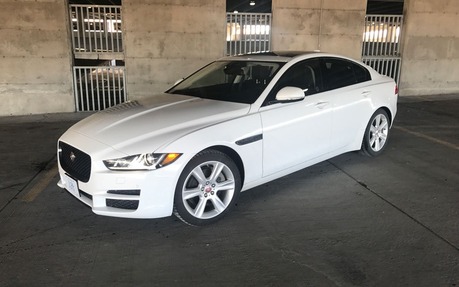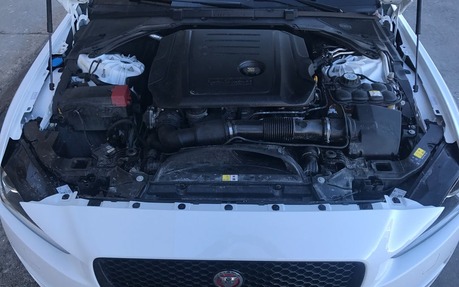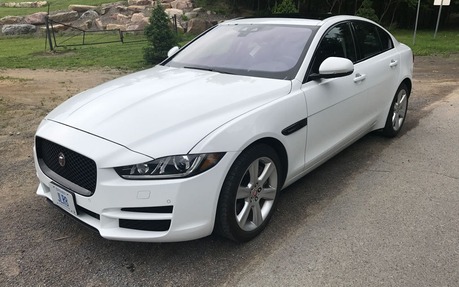2017 Jaguar XE 20d: Taking Aim at the 3 Series
Jaguar takes aim directly at competitors such as the BMW 3 Series, Mercedes-Benz C-Class and Audi A4 with the introduction of the 2017 XE. The XE rounds out the Jaguar sedan lineup as the new point of entry to Jaguar ownership, joining the recently redesigned Jaguar XF midsize sedan and aging Jaguar XJ full-size luxury sedan.
This is a new model for Jaguar and prior to its release, the British manufacturer didn’t have anything to compete in this lucrative segment. As is usually the case with automakers that use letters and numbers for their nameplates, a point of reference is needed: the XE competes with the BMW 3 Series, the XF with the 5 Series and the XJ with the 7 Series. I can’t tell you how many times I had to repeat this comparison to people when they asked what an XE was.

This car is a real looker—probably the nicest in its segment, though naturally, looks are subjective. There is something about the Jag that attracts even the random person on the street who knows nothing about cars. Jaguar has moulded its signature design cues into the XE with contemporary lines and sporty flair. The LED daytime running lights and LED taillights are particularly nice, but one thing that takes spoils it all is the presence of incandescent light bulb front turn signals. Everything should be LED in 2017—especially on a luxury vehicle.
The interior of the XE is as upscale as you would expect. It’s eloquent but not cluttered, giving a minimalist, yet classy look. Even the gearshift knob sinks into the console when the vehicle is turned off for a flush surface. I get the appeal of the dial, but it’s not my favourite type of gear selector simply because it makes quick selections a little more difficult. That extra second for the knob to slide up and out of the console was noticeable.
Black piano and aluminum finishing materials in the cabin are very nice to the touch and give an aura of quality. The steering wheel is plain but functional, though I would opt for a less confusing button configuration for operating the vehicle info systems, as some buttons serve dual purposes and I got mixed up easily.
In North America, the XE is available with a choice of three powertrains: a 340-horsepower supercharged 3.0-litre V6, a 240-horsepower 2.0-litre turbocharged gasoline four-cylinder and the 20d (our test vehicle) with a 180-horsepower 2.0-litre turbo-diesel four-cylinder. A ZF eight-speed automatic transmission routes power to the wheels across the entire range of engines available in the XE.
Diesels are known to be a bit odd-sounding, a bit clattery, but the noise emanating from under the hood on startup was about as good as one could expect. It’s interesting because the larger XF I tested with the same engine seemed quite a bit louder, which is not what you want in an upscale luxury sedan.

The 180 horses aren’t scorching overall, but the XE had a very nice amount of pull as soon as I hit the gas. The low-end torque is impressive and perfect for daily city driving. What’s also great for city driving is the stellar fuel economy. In fact, it’s the most fuel-efficient car I’ve tested in a year, beating out the Honda Accord Hybrid and even a MINI. I managed just 6.4 L/100 km during my week with the vehicle.
Like its siblings in the Jaguar lineup, the XE uses a torque on-demand AWD system featuring a transfer case with a multi-plate wet clutch pack and a chain drive to the front prop shaft. It's a fast-acting system and can make the transition from purely rear-wheel drive to all-wheel drive in just 165 milliseconds, according to Jaguar. In normal driving, all of the engine's torque is sent to the rear axle, preserving the rear-wheel-drive dynamics of the XE, and ensuring that steering feel remains uncorrupted. During slippage, up to 90% of the torque can be shifted to the front wheels if necessary.
The Jaguar XE can be equipped with numerous safety and technology features. One such new feature is Jaguar’s All-Surface Progress Control. This system works like a low-speed cruise control, and is designed to precisely control brake and powertrain systems delivering optimum traction in a variety of road conditions. Also available are head-up display technology, automatic emergency braking, traffic sign recognition and the entire suite of driving assistance features that you’ve come to expect.
The base 2017 Jaguar XE 20d starts at $45,900. As you move up the food chain to the Prestige and R-Sport trims, the price can increase quite dramatically to over $66,000. The XE represents very good value for people looking to avoid the mainstream and stand out a little, and the Jaguar nameplate is certain to pull away some BMW or Mercedes-Benz owners.
| Test drive report | |
| Test model | 2017 Jaguar XE |
|---|---|
| Trim level | Premium 20d |
| Price range | $45,000 – $57,500 |
| Price as tested | 45 000 $ |
| Warranty (basic) | 4 years/80,000 km |
| Warranty (powertrain) | 5 years/80,000 km |
| Fuel economy (city/highway/observed) | 6,0 / 4,2 / 6,4 L/100km |
| Options | N/A |
| Competitive models | Acura TLX, Audi A4, BMW 3 Series, Cadillac ATS, Infiniti Q50, Lexus IS, Lincoln MKZ, Mercedes-Benz C-Class, Volvo S60 |
| Strong points |
|
| Weak points |
|
| Editor's rating | |
| Fuel economy | The first 5/5 rating I've ever given. |
| Comfort | Very comfortable all around. |
| Performance | Not fast, but enough low-end torque to make up for it. |
| Infotainment | Adequate, but not memorable. |
| Driving | Handles well and holds the road firmly. |
| Overall | A great package that is sure to peel away BMW/Mercedes/Audi buyers. |
